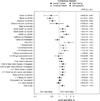Driving after drinking among young adults of different race/ethnicities in the United States: unique risk factors in early adolescence?
- PMID: 23608720
- PMCID: PMC3634100
- DOI: 10.1016/j.jadohealth.2012.10.274
Driving after drinking among young adults of different race/ethnicities in the United States: unique risk factors in early adolescence?
Abstract
Purpose: National guidelines for alcohol screening and brief interventions advise practitioners to consider age, drinking frequency, and context to identify at-risk youth. The purpose of this study was to identify the contextual risk and protective factors in high school-aged adolescents associated with future driving after drinking (Drinking Under the Influence [DUI] at age 21) by race/ethnicity.
Methods: Data included 10,271 adolescents (67% white, 12% Hispanic, 16% black, 3.6% Asian; 49% Male) who participated in the National Longitudinal Study of Adolescent Health (Waves I, II, and III) from 1995 to 2001. A lagged panel design and survey logistic regression was used to examine the association between multiple contextual factors (e.g., demographics, parents, peers, social context) during adolescence and self-reported DUI in young adulthood.
Results: As expected, the likelihood of DUI was higher among whites followed by Hispanics, Asians, and blacks in all models. Perception of easy home access to alcohol increased risk for future DUI for whites (OR: 1.25 CI: 1.04-1.49), Hispanics (OR: 2.02 CI: 1.29-3.16), and Asians (OR: 1.90 CI: 1.13-3.22), but not for black youth. Drinking frequency and prior DUI were not risk factors for Hispanics. Risk-taking attitudes, marijuana use, and religious affiliation were risk factors for whites only.
Conclusions: Findings suggest that in addition to screening for drinking behaviors, brief interventions and prevention efforts should assess perceived home access to alcohol and other race-specific factors to reduce alcohol-related injuries and harm.
Copyright © 2013 Society for Adolescent Health and Medicine. Published by Elsevier Inc. All rights reserved.
Figures


Similar articles
-
Drinking and driving among immigrant and US-born Hispanic young adults: results from a longitudinal and nationally representative study.Addict Behav. 2011 Apr;36(4):381-8. doi: 10.1016/j.addbeh.2010.12.017. Epub 2010 Dec 21. Addict Behav. 2011. PMID: 21216535 Free PMC article.
-
The role of parental alcohol consumption on driving under the influence of alcohol: results from a longitudinal, nationally representative sample.Accid Anal Prev. 2011 Nov;43(6):2182-2187. doi: 10.1016/j.aap.2011.06.012. Epub 2011 Jul 12. Accid Anal Prev. 2011. PMID: 21819850 Free PMC article.
-
Identifying social mechanisms for the prevention of adolescent drinking and driving.Accid Anal Prev. 2008 Mar;40(2):576-85. doi: 10.1016/j.aap.2007.08.013. Epub 2007 Sep 19. Accid Anal Prev. 2008. PMID: 18329409 Free PMC article.
-
Driving Under the Influence of Alcohol, Cannabis, and Delta-8 THC: Perceived Likelihood, Risk Perceptions, and Behaviors.J Psychoactive Drugs. 2025 Apr-Jun;57(2):213-222. doi: 10.1080/02791072.2024.2339506. Epub 2024 Apr 9. J Psychoactive Drugs. 2025. PMID: 38590250
-
Associations between driving under the influence or riding with an impaired driver and future substance use among adolescents.Traffic Inj Prev. 2019;20(6):563-569. doi: 10.1080/15389588.2019.1615620. Epub 2019 Jul 29. Traffic Inj Prev. 2019. PMID: 31356125 Free PMC article. Clinical Trial.
Cited by
-
Association between a delay in driving licensure and driving while impaired and riding with an impaired driver among emerging adults.Alcohol Clin Exp Res. 2021 Apr;45(4):793-801. doi: 10.1111/acer.14585. Epub 2021 Apr 3. Alcohol Clin Exp Res. 2021. PMID: 33616239 Free PMC article.
-
Daily level predictors of impaired driving behaviors in young adults: Protocol design for utilizing daily assessments.PLoS One. 2022 Sep 27;17(9):e0275190. doi: 10.1371/journal.pone.0275190. eCollection 2022. PLoS One. 2022. PMID: 36166452 Free PMC article.
-
Regarding driving after drug and alcohol use among US high school seniors.Am J Public Health. 2014 Apr;104(4):e7. doi: 10.2105/AJPH.2013.301839. Epub 2014 Feb 13. Am J Public Health. 2014. PMID: 24524536 Free PMC article. No abstract available.
-
Drinking and Driving among University Students in 22 Low, Middle Income and Emerging Economy Countries.Iran J Public Health. 2015 Oct;44(10):1330-8. Iran J Public Health. 2015. PMID: 26576345 Free PMC article.
-
Adolescence, attention allocation, and driving safety.J Adolesc Health. 2014 May;54(5 Suppl):S6-15. doi: 10.1016/j.jadohealth.2013.10.202. J Adolesc Health. 2014. PMID: 24759442 Free PMC article. Review.
References
-
- Substance Abuse and Mental Health Services Administration. The NSDUH report: State estimates of drunk and drugged driving. Rockville, MD: Center for Behavioral Health Statistics and Quality; 2010. Available from:
-
- Substance Abuse and Mental Health Services Administration. Results from the 2010 National Survey on Drug Use and Health: Summary of national findings. Rockville, MD: Center for Behavioral Health Statistics and Quality; 2011. Available from: http://www.samhsa.gov/data/NSDUH/2k10NSDUH/2k10Results.htm#3.1.1.
-
- Centers for Disease Control and Prevention. Vital signs: Alcohol-impaired driving among adults - United States, 2010. Morbidity and Mortality Weekly Report. 2011;60(39):1351–1356. - PubMed
-
- National Highway Traffic Safety Administration. [cited June 28, 2012];Traffic safety facts 2009: Alcohol impaired driving. 2010 Available from: http://www-nrd.nhtsa.dot.gov/Pubs/811385.PDF.
-
- United States Census Bureau. Alcohol involvement for drivers in fatal crashes. [cited June 28, 2012];The 2012 Statistical Abstract. 2012 Available from: http://www.census.gov/compendia/statab/2012/tables/12s1113.pdf.
Publication types
MeSH terms
Grants and funding
LinkOut - more resources
Full Text Sources
Other Literature Sources
Medical
Research Materials

